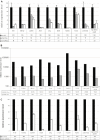Single copy shRNA configuration for ubiquitous gene knockdown in mice
- PMID: 15831785
- PMCID: PMC1079974
- DOI: 10.1093/nar/gni065
Single copy shRNA configuration for ubiquitous gene knockdown in mice
Abstract
RNA interference through the expression of small hairpin RNA (shRNA) molecules has become a very promising tool in reverse mouse genetics as it may allow inexpensive and rapid gene function analysis in vivo. However, the prerequisites for ubiquitous and reproducible shRNA expression are not well defined. Here we show that a single copy shRNA-transgene can mediate body-wide gene silencing in mice when inserted in a defined locus of the genome. The most commonly used promoters for shRNA expression, H1 and U6, showed a comparably broad activity in this configuration. Taken together, the results define a novel approach for efficient interference with expression of defined genes in vivo. Moreover, we provide a rapid strategy for the production of gene knockdown mice combining recombinase mediated cassette exchange and tetraploid blastocyst complementation approaches.
Figures





Similar articles
-
Reproducible and inducible knockdown of gene expression in mice.Genesis. 2006 May;44(5):252-61. doi: 10.1002/dvg.20213. Genesis. 2006. PMID: 16676321
-
Conditional RNAi in mice.Methods. 2011 Feb;53(2):142-50. doi: 10.1016/j.ymeth.2010.08.003. Epub 2010 Aug 10. Methods. 2011. PMID: 20705138 Review.
-
Stable RNA interference: comparison of U6 and H1 promoters in endothelial cells and in mouse brain.J Gene Med. 2006 Apr;8(4):433-41. doi: 10.1002/jgm.860. J Gene Med. 2006. PMID: 16389634
-
Gene knockdown in the mouse through RNAi.Methods Enzymol. 2010;477:387-414. doi: 10.1016/S0076-6879(10)77020-8. Methods Enzymol. 2010. PMID: 20699152
-
RNA interference in mice.Handb Exp Pharmacol. 2007;(178):149-76. doi: 10.1007/978-3-540-35109-2_7. Handb Exp Pharmacol. 2007. PMID: 17203655 Review.
Cited by
-
Gonadotrope plasticity at cellular and population levels.Endocrinology. 2012 Oct;153(10):4729-39. doi: 10.1210/en.2012-1360. Epub 2012 Aug 14. Endocrinology. 2012. PMID: 22893721 Free PMC article.
-
Conditional brain-specific knockdown of MAPK using Cre/loxP regulated RNA interference.Nucleic Acids Res. 2007;35(12):e90. doi: 10.1093/nar/gkm475. Epub 2007 Jun 22. Nucleic Acids Res. 2007. PMID: 17586814 Free PMC article.
-
RNAi-mediated germline knockdown of FABP4 increases body weight but does not improve the deranged nutrient metabolism of diet-induced obese mice.Int J Obes (Lond). 2011 Feb;35(2):217-25. doi: 10.1038/ijo.2010.128. Epub 2010 Jul 6. Int J Obes (Lond). 2011. PMID: 20603627 Free PMC article.
-
Efficient inhibition of human cytomegalovirus DNA polymerase expression by small hairpin RNA in vitro.Curr Microbiol. 2008 Nov;57(5):395-400. doi: 10.1007/s00284-008-9210-0. Epub 2008 Aug 5. Curr Microbiol. 2008. PMID: 18679747
-
Focal segmental glomerulosclerosis is induced by microRNA-193a and its downregulation of WT1.Nat Med. 2013 Apr;19(4):481-7. doi: 10.1038/nm.3142. Epub 2013 Mar 17. Nat Med. 2013. PMID: 23502960
References
-
- Fire A., Xu S., Montgomery M.K., Kostas S.A., Driver S.E., Mello C.C. Potent and specific genetic interference by double-stranded RNA in Caenorhabditis elegans. Nature. 1998;391:806–811. - PubMed
-
- Brummelkamp T.R., Bernards R., Agami R. A system for stable expression of short interfering RNAs in mammalian cells. Science. 2002;296:550–553. - PubMed
-
- Tuschl T. Expanding small RNA interference. Nat. Biotechnol. 2002;20:446–448. - PubMed
-
- Kunath T., Gish G., Lickert H., Jones N., Pawson T., Rossant J. Transgenic RNA interference in ES cell-derived embryos recapitulates a genetic null phenotype. Nat. Biotechnol. 2003;21:559–561. - PubMed
-
- Rubinson D.A., Dillon C.P., Kwiatkowski A.V., Sievers C., Yang L., Kopinja J., Rooney D.L., Ihrig M.M., McManus M.T., Gertler F.B., et al. A lentivirus-based system to functionally silence genes in primary mammalian cells, stem cells and transgenic mice by RNA interference. Nature Genet. 2003;33:401–406. - PubMed
Publication types
MeSH terms
Substances
LinkOut - more resources
Full Text Sources
Other Literature Sources
Molecular Biology Databases

